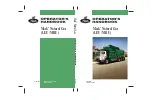
When the vehicle is stationary and the transmis‐
sion is in neutral, the engine has delayed throttle
response.
If the drive wheels spin when pulling away, switch
on the starting-off aid (
/
page 266).
Perform a brake test when starting the journey.
Pay attention to the traffic situation while doing
this.
Warm up the engine quickly by driving at moder‐
ate engine speeds. Depending on the outside
temperature, after approximately 10 to 20
minutes the engine will reach its operating tem‐
perature of approximately 85 to 100 °C. You can
utilise the full engine power output once the
engine has reached normal operating tempera‐
ture.
Notes on stopping and switching off the
engine
&
WARNING Risk of fire caused by hot
exhaust system parts
Flammable material such as leaves, grass or
twigs may ignite if they come into contact
with hot parts of the exhaust system or
exhaust gas flow.
#
Park the vehicle so that no flammable
material can come into contact with hot
vehicle components.
#
In particular, do not park on dry grass‐
land or harvested grain fields.
&
WARNING Risk of accident on uphill and
downhill gradients
On uphill and downhill gradients, the parking
brake might not be sufficient to secure the
vehicle.
A vehicle with trailer/semitrailer or a loaded
vehicle can roll away.
#
In the check position, check whether
the parking brake alone is sufficient to
hold the complete vehicle.
#
Always secure the towing vehicle and
trailer/semitrailer with the parking
brake and additionally with wheel
chocks.
&
WARNING Risk of accident when switch‐
ing off the ignition when driving
If you switch off the ignition while driving,
safety functions are restricted or no longer
available. This may affect the power steering
system and the brake force boosting, for
example.
You will then need to use considerably more
force to steer and brake.
#
Do not switch off the ignition while driv‐
ing.
&
WARNING Risk of accident and injury
due to children left unattended in the
vehicle
If children are left unattended in the vehicle,
they could:
R
Open doors, thereby endangering other
persons or road users.
R
Get out and be struck by oncoming traf‐
fic.
R
Operate vehicle equipment and become
trapped, for example.
In addition, the children could also set the
vehicle in motion, for example by:
R
Releasing the parking brake.
R
Changing the transmission position.
R
Starting the vehicle.
#
Never leave children unattended in the
vehicle.
#
When leaving the vehicle, always take
the key with you and lock the vehicle.
#
Keep the vehicle key out of reach of
children.
Ensure that you observe the safety notes in the
"Children in the vehicle" section (
/
page 38).
You can find information on crawler mode in the
"Automated manual transmission" section
(
/
page 218).
Vehicles with automated manual transmission:
After the vehicle has been stopped with crawler
mode activated, the vehicle begins to crawl again
in the following cases:
R
the transmission is not shifted into neutral
R
the parking brake is not applied
R
the service brake is released again
Driving mode
203
Содержание Actros
Страница 21: ......






































